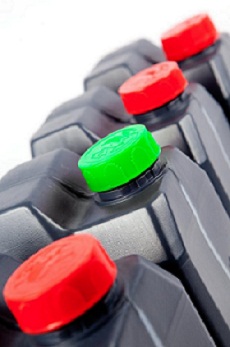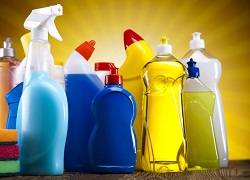 With an increase in the use of synthetic products, the amount of hazardous waste being generated by households is also elevating. Amongst others, volatile organic compounds (VOCs) are the most harmful pollutants households are producing at an enormously high rate.
With an increase in the use of synthetic products, the amount of hazardous waste being generated by households is also elevating. Amongst others, volatile organic compounds (VOCs) are the most harmful pollutants households are producing at an enormously high rate.
VOCs are gaseous substances emitted from certain solids and liquids, including a variety of chemicals and light organic matters. With their ability to cause carcinogenic and develop photochemical ozone smog, these compounds may have both long and short term health effects on humans.
VOCs are typically found in building materials, cleaning products, interior furnishing, and personal care products. In a study, the U.S. Environmental Protection Agency (U.S. EPA) has found that the concentration of VOCs is much higher in the indoor environment than in the outdoors. With up to hundreds of individual VOCs in the indoor at any given time, these substances may have ten times greater impact inside the home than the on the outside environment.
Volatile Organic Compounds (VOCs) in Home
 VOCs are a group of carbon-based chemicals with high vapor pressure at ordinary room temperature. Due to their high vapor pressure, these compounds sublimate and evaporate in the environment to mix in and affect the concentration of the surrounding air.
VOCs are a group of carbon-based chemicals with high vapor pressure at ordinary room temperature. Due to their high vapor pressure, these compounds sublimate and evaporate in the environment to mix in and affect the concentration of the surrounding air.
VOCs may include both natural and synthetic chemical compounds. Some common VOCs found in homes include formaldehyde, ethanol, ether, propane, benzene, vinyl chloride, and carbon tetrachloride. While some VOCs may produce very high level of odor, others may have no scent, thus indicating no sign of risks or danger.
Where Do VOCs Come From?
 Formaldehyde is amongst the most common VOCs found in homes. It is a colorless gas with very strong odor. The substance is common in construction materials, such as paint, floor finishes, particleboards, plywood, glues, and foam insulation. Other sources may include drapes and fabrics, tobacco products, and several types of fuels, such as wood, gas, and kerosene. Besides this, certain personal care products, including hair sprays, perfumes, tissue paper, dry cleaning liquids, cleaning agents, lacquers, artwork materials, and copying and printing machines may also emit some amount of VOCs. These materials may produce toxic fumes during use and, to some degree, when they are stored. However, the amount of emission may reduce as the product ages.
Formaldehyde is amongst the most common VOCs found in homes. It is a colorless gas with very strong odor. The substance is common in construction materials, such as paint, floor finishes, particleboards, plywood, glues, and foam insulation. Other sources may include drapes and fabrics, tobacco products, and several types of fuels, such as wood, gas, and kerosene. Besides this, certain personal care products, including hair sprays, perfumes, tissue paper, dry cleaning liquids, cleaning agents, lacquers, artwork materials, and copying and printing machines may also emit some amount of VOCs. These materials may produce toxic fumes during use and, to some degree, when they are stored. However, the amount of emission may reduce as the product ages.
How VOCs Affect Human Health
Some VOCs may be toxic and can cause serious harm to the environment and human health. Depending upon the person’s sensitivity to chemical toxicity, the effects of the chemicals may vary greatly from person to person. Besides, the nature and severity of the condition may also depend on the level and the length of the exposure to the VOCs. Some common symptoms of short term exposure to VOCs may include irritation in the eyes, nose, and throat, mild to severe headache, nausea, dizziness, drowsiness, fatigue, light headedness, allergic skin reaction, and respiratory problems. In case of higher concentration of VOCs or prolonged exposure, the person may even experience damage to liver, central nervous system, or kidney, loss of memory, visual disorders, and even chronic diseases like cancer.
As people are increasingly using products containing organic substances, households are at high risk of exposure to pollutants and resulting health conditions. Here is how you can reduce your exposure to toxic VOCs and limit risks to your health.
Discard Chemical Containers Safely
Gases can emit even from closed containers found in your home. Make sure that you throw away every old or unneeded chemical safely to limit the concentration of organic chemicals in your home. Rather than simply tossing the unwanted chemical cans in the trash, find out if your local community has a hazardous waste collection program to dispose of these toxic items with minimal impact on the environment.
Minimize the Use of Products Containing Methylene Chloride
Paint strippers, aerosol spray paints, and adhesive removers contain considerable amount of methylene chloride. The substance is particularly known to cause cancer in humans and animals. Moreover, it may convert into carbon monoxide in the body, which may lead to a number of chronic health conditions. Considering this, researchers strongly suggest the use of products containing methylene chloride in the outdoors only. If you are using the chemical in the indoors, make sure that the area is well-ventilated to avoid the containment of the chemical in the home.
Conduct a Test for VOCs Toxicity
The best measure to limit the exposure to VOCs is reducing the level of organic chemicals in the home. Testing may help you identify potential contaminants and indoor air pollution problems in the environment. Although home screening kits are available to measure VOCs level in home, it is best to hire a professional consultant for a thorough inspection to identify the sources of VOCs. Some states have also established Health Risk Values (HRVs) for some individual VOCs. Once you know the source and the risks of VOCs present in your home, you can take the most effective action to reduce your exposure to the harmful substances.
If you are looking to test your home for VOCs, fill out our contact form or give us a call at (863) 682-5897 to get expert services for the identification of VOCs today!
